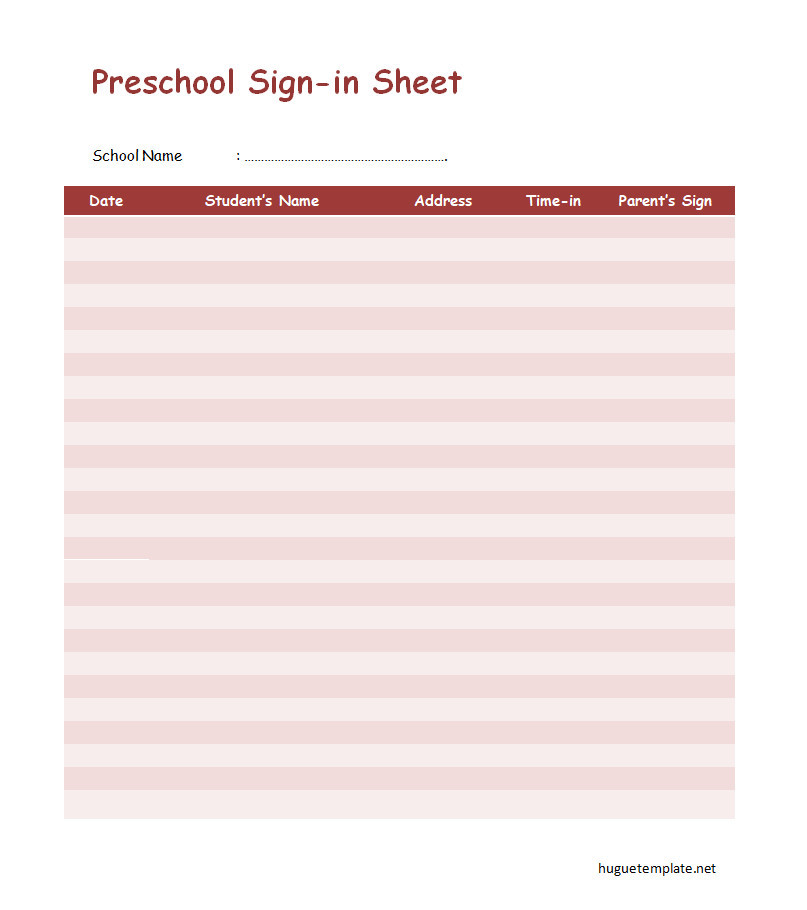When running a preschool program, keeping track of the students who attend on a given day is crucial. Not only does it help ensure the safety and security of the children, but it also provides important information for administrative purposes. One effective way to track the attendance of preschoolers is by using a sign-in sheet.
This article will discuss what a preschool sign-in sheet is, how to create one, how to use it effectively, and provide some classroom management tips for preschool teachers.
What is a Preschool Sign-In Sheet?
A preschool sign-in sheet is a document used to record the attendance of students in a preschool program. It typically includes fields for the child’s name, the date, and a space for the parent or guardian to sign in and out. By having parents or guardians verify their child’s attendance, preschool administrators can ensure that children are accounted for and that they are being picked up by authorized individuals.

Creating a sign-in sheet for a preschool is relatively simple. You can design your own using a word processing program or find templates online that can be customized to fit your specific needs. Here are the steps to create a sign-in sheet:
How to Create a Sign-In Sheet for a Preschool
- Decide what information you want to collect on the sign-in sheet. This usually includes the child’s name, the date, and spaces for the parent or guardian to sign in and out.
- Decide how you want to organize the information on the sheet. You can have separate columns for each field or use a more compact design with the fields arranged vertically.
- Include a header at the top of the sheet with the name of your preschool or program, along with any other relevant information, such as the program’s hours or contact information.
- Make the sign-in sheet visually appealing by adding colors, graphics, or your preschool’s logo. However, make sure the design does not distract from the important information.
- Once you have finalized the design, print copies of the sign-in sheet and distribute them to parents or guardians. Consider placing them in a designated area near the entrance of the preschool for easy access.
How to Use a Sign-In Sheet Effectively
Once you have created a sign-in sheet, it’s important to use it effectively to maximize its benefits. Here are some tips:
- Place the sign-in sheet in a visible location: Position the sign-in sheet in a place where parents or guardians can easily see it and access it. This will encourage them to sign in and out consistently.
- Remind parents or guardians to sign in and out: Make sure to communicate the importance of signing in and out to parents or guardians. Remind them verbally and through written notices to ensure compliance.
- Review the sign-in sheet regularly: Take the time to review the sign-in sheet regularly to ensure accuracy and completeness. Look for any patterns or discrepancies that may require further attention.
- Keep the sign-in sheets organized: Establish a system for organizing and storing the sign-in sheets. This will make it easier to refer back to them if needed and maintain a record of attendance.
- Use the sign-in sheet for emergency purposes: In the event of an emergency or evacuation, having an up-to-date sign-in sheet can help account for all the children and ensure their safety.
Classroom Management Tips for Preschool Teachers
In addition to using a sign-in sheet, preschool teachers can implement various strategies to effectively manage their classrooms. Here are some tips:
1. Establish a daily routine:
Having a consistent daily routine helps preschoolers feel secure and know what to expect. Create a schedule that includes time for learning, play, snacks, and naps. Communicate the routine to both the children and their parents or guardians.
2. Set clear expectations and rules:
Establishing clear expectations and rules from the beginning will help maintain a positive and structured learning environment. Teach the children the rules and consistently reinforce them. Encourage positive behavior and provide appropriate consequences for misbehavior.
3. Use positive reinforcement:
Positive reinforcement is an effective way to encourage desired behaviors in preschoolers. Praise and reward children when they exhibit positive behavior, such as sharing, following instructions, or showing kindness to others. This will motivate them to continue behaving appropriately.
4. Create engaging lesson plans:
Design lesson plans that are interactive and engaging for preschoolers. Incorporate hands-on activities, games, and visual aids to make learning fun and memorable. Vary the activities to cater to different learning styles and keep the children interested.
5. Foster a supportive classroom environment:
Create a classroom environment that promotes inclusivity, respect, and empathy. Encourage children to be kind to one another, share their toys, and help each other. Teach them about diversity and celebrate different cultures and backgrounds.
6. Communicate effectively with parents or guardians:
Regularly communicate with parents or guardians to keep them informed about their child’s progress, upcoming events, and any concerns. Use various channels of communication, such as newsletters, parent-teacher conferences, and emails. Encourage parents to be actively involved in their child’s education.
7. Practice patience and flexibility:
Working with preschoolers requires a great deal of patience and flexibility. Understand that each child is unique and may have different needs and abilities. Be adaptable and willing to modify your teaching strategies to accommodate individual differences.
8. Promote independence and self-help skills:
Encourage preschoolers to develop independence and self-help skills. Teach them age-appropriate tasks, such as putting on their shoes, using the restroom independently, and cleaning up after themselves. This will foster their confidence and self-esteem.
9. Incorporate sensory experiences:
Preschoolers learn best through hands-on experiences. Incorporate sensory activities, such as playing with sand, water, or clay, to stimulate their senses and enhance their cognitive and motor skills. Provide opportunities for exploration and discovery.
10. Create a positive and nurturing relationship with each child:
Build a positive and nurturing relationship with each child in your preschool program. Show genuine interest in their well-being and development. Offer support, encouragement, and praise to help them thrive and grow.
Free Preschool Sign-in Sheet Template!
A preschool sign-in sheet is a valuable tool for tracking the attendance of students in a preschool program. By creating and using a sign-in sheet effectively, preschool administrators can ensure the safety and security of the children, as well as maintain accurate records for administrative purposes.
Use our preschool sign-in sheet template in Word to easily track attendance and manage daily sign-ins for your preschool or daycare.
Perfect for teachers and caregivers, this customizable template helps you keep organized records of student arrivals and departures.
Simplify your sign-in process and enhance classroom management with this user-friendly, free template. Get started today!
Preschool Sign-in Sheet Template – Word

I am Huguette Prudence, the writer and curator of this website. With a profound passion for writing and reading, I strive to create insightful and engaging content. My background includes managing a small online shop and overseeing a business website, experiences that have honed my skills and broadened my understanding of effective online communication. Thank you for visiting Huguetemplate.net, where I aim to share knowledge and inspiration through carefully crafted content.